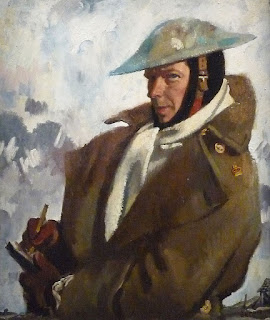Born in Stillorgan, County Dublin, on 27th November 1878, William Orpen was the fourth and youngest son of Arthur Herbert Orpen (1830–1926), a solicitor, and his wife, Anne, nee Caulfield. Both his parents were amateur artists, and his eldest brother, Richard Caulfield Orpen, became a notable architect. William was a naturally talented painter and shortly before his thirteenth birthday his parents enrolled him in the Dublin Metropolitan School of Art. During his six years at the college, William won every major prize.
In 1901, William held a solo exhibition at the Carfax Gallery in London. That year, he married Grace Knewstub, the sister-in-law of the artist Sir William Rothenstein. They had three daughters but the marriage was not a happy one and, by 1908, William had begun a long running affair with Mrs Evelyn Saint-George, a well-connected American millionairess based in London
During the First World War, William was the most prolific of the official war artists sent by Britain to the Western Front. Although he was made a Knight Commander of the Order of the British Empire in the 1918 King's birthday honours list, and also elected a member of the Royal Academy of Arts, his determination to serve as a war artist cost him both his health and his social standing in Britain.
In December 1915, William was commissioned into the Army Service Corps and reported for clerical duty at London's Kensington Barracks in March 1916. Throughout 1916, he continued painting portraits, most notably one of a despondent Winston Churchill. In January 1917, the “Daily Mirror” reported that Field Marshal Douglas Haig himself had "conferred" on William the title of Official Artist with the British Army in France. The other artists on the Department of Information War Artist scheme had the honorary rank of second lieutenant and were restricted to three weeks visiting the Western Front, whereas, William was promoted to the rank of Major and given indefinite permission to remain at the Front. An officer from Kensington Barracks was appointed as his military aide, a car and driver were made available in France and Orpen paid for a batman and assistant to accompany him.
When the war ended the Imperial War Museum commissioned William to remain in France and paint three large group portraits of the delegates to Paris Peace Conference. He moved to Paris in January 1919 to begin work on his next commission and during 1919 painted individual portraits of the delegates to the Conference which formed the basis of his two large paintings, “A Peace Conference at the Quai d'Orsay” and “The Signing of Peace in the Hall of Mirrors”.
William considered that the whole conference was being conducted with a lack of respect or regard to the suffering of the soldiers who fought in the war and he attempted to address this in the third painting of the commission. This picture was to show the delegates and military leaders as they entered the Hall of Mirrors to sign the Treaty of Versailles.
After the war William returned to painting society portraits and enjoyed great commercial success. In May 1931, he became seriously ill and, after suffering periods of memory loss, died aged 52 in London, on 29th September 1931. William was buried in Putney Vale Cemetery. A stone tablet in the Island of Ireland Peace Park Memorial, Messines, Belgium, commemorates him.
